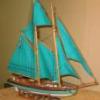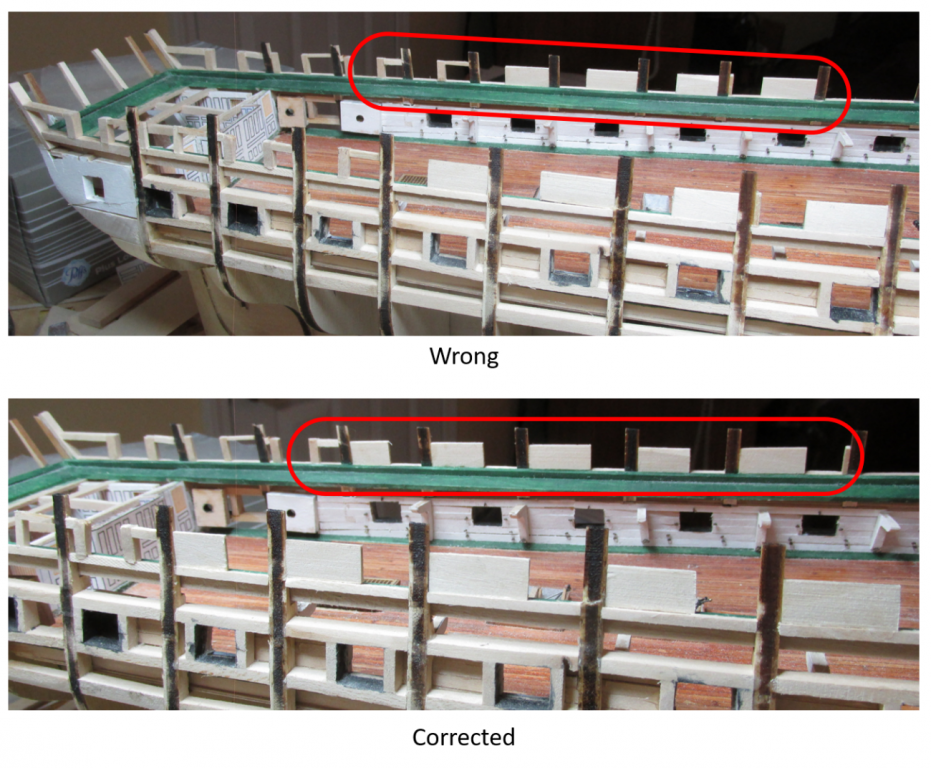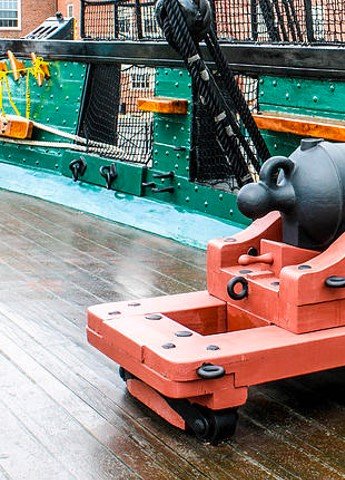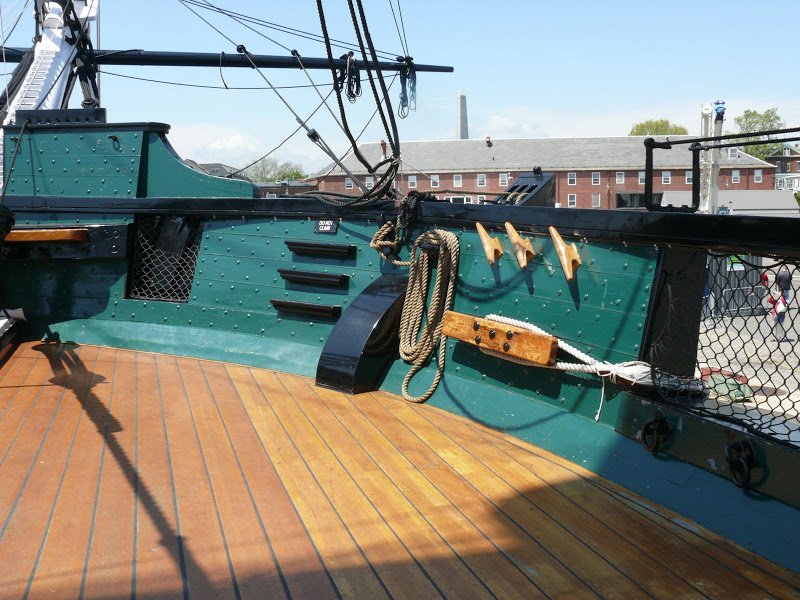-
Posts
2,623 -
Joined
-
Last visited
Content Type
Profiles
Forums
Gallery
Events
Everything posted by JSGerson
-
Thanks for the complements albeit a bit undeserved. To paraphrase an old saying, I'm standing on the shoulders of some might great builders. As for video recording, I build so slow that by the time I finish, today's video type, standard, method, etc. would be obsolete and YouTube would probable go the way of MySpace 8-). I've 2 1/2 years so far into this project and I'm 72 years of age. It's a race to see who finishes first!!!
-
First off, let me give ArthurN and mtdoramike kudos for completing their versions of the Conny. I hope to join those fellow builders who have accomplished that feat no matter what they think of their skills. A lot of people start a model, and never finish. This is only my second wooden square-rigged ship model so hopefully I haven’t bitten off more than I can chew. The MS model presently being sold is based on the 1926 restoration. That restoration has come under some criticism for some historical inaccuracies like the replicated cannons and the top gallant bulwark extensions. I am, for the most part, basing my build on the last restoration started in 2015 which is continuing to bring the ship back closer to its 1812 configuration. In addition, I decided to add detail to the gun deck as well. This has resulted in a large amount of scratch building, something I learned constructing the Rattlesnake following Robert Hunt’s practicum. This time I’m using Mr. Hunt’s USS Constitution practicum as a guide, not an absolute “how to” as before. I’m using a lot of other builder’s build logs as a guide as well. I also purchased the Mamoli plans from a fellow builder to be used as a cross reference and I also have numerous reference books on the Conny. From what I can tell and based on my limited experience, very few people follow kit instructions completely. Like you mtdoramike, my model also has wood from the actual ship which I was able to purchase mail order through the gift shop back in 2016. I got what I got; I had no choice in size or shape. I would have thought there would be a whole new supply during this last restoration, however, I have not seen any for sale lately. I’ve already incorporated some of that wood in the keel. Per your suggestions, I’ll try and incorporate more as the build progresses.
-
Almost a month has gone by. Where does the time fly???!!! I’ve completed adding the simulated bolt heads to the remaining starboard and port bulwarks. On average, each panel takes at most two hours of intense concentration due to the itsy-bitsy teeny weeny (that’s a technical term) size of the brass punched elements to punch, position, and attach them to the bulwarks. I still need to make the panels for the stern. I must have made about a thousand of them due including mis-shaped or lost pieces. I also wore out another punch, but because I got two replacement punches (no cost) for the one that broke earlier, I had a spare. In the images below, you will notice that I have dry fitted the large and small cleats. Their mounting pins have yet to be trimmed. You will also notice that four bulwark panels have a rectangular hole cut into them. These will become the bulwark sheaves. There is still a bit of work left such as fitting the pin rails, painting the bulwarks green and mounting them onto the model. Then of course there is the work on the stern bulwarks. All this will have to wait as I will be closing the shipyard for a couple of weeks for other personal activities.
-
Luckily the fix wasn’t too hard at all. Due to the thin gluing surfaces, removing one frame and the solid wood pieces from each side was fairly quick and simple. A few delicate “wiggles” and the PVC glued parts came off. As rule, I’ve been using PVC glue on the framing so far to allow me the luxury of being able to fine tune the positioning before the glue set. That gave the joint a little flexibility which led to its ease of removal. The only part I had to remake was the first piece to the far left inside the red elongated circle of the “corrected” image below. The others came off the model so cleanly I was able to reuse them with a little fine tuning with a file. All I had to do was shift them aft. Note, I only circled the far side as it is easier to see. I now have to check all the plywood backed planking dimensions before I can proceed.
-
Well, I hit a near disastrous “oops.” If you go back into my log where I’m framing the spar deck gun ports, you will remember I switched from creating post and header frames to using solid pieces of wood. Unfortunately, On the last port before I made the switch, I got confused as to which side of the vertical post was to be the gun port and placed the horizontal header on the wrong side of the post. This moved the port to the wrong position. Then I created the remaining ports with the solid wood based on that last port. So, all the ports forward of the third gun port from the transom were wrong and those must be re-positioned. Since I was working both sides of the model at the same time, both sides were affected. I say a “near disaster” because I hadn’t finished the creating the bulwarks. I only made the plywood pieces with the glued-on planks. I could have punched out all the hundreds of bolt heads, applied them to the bulwark surface, painted them and glued them into position on the model. Or I could have been planking the hull wale like other builders at this stage. Hey, you have to look at the bright side. This error was discovered when I was trying to figure which bulwarks required the bulwark sheaves. The plans showed a wide bulwark and my model indicated it was a relatively narrow one. I’ll show the before and after images once I fix and make the “after.”
-
Finally, before I would fasten the bulwarks to the hull, I needed to add the cannon rigging eye bolts to both the bulwarks and the planking just above the waterway. I thought doing that now would be easier rather do doing it later. The blackened eyebolt openings are 3/32” dia. So, they may be difficult to see. Here are all the bulwarks so far (about 1/3) glued into place. The construct continues.
-
Additional to the hardware and pin rails on the bulwarks, the opening for the bow anchors had a couple of eyebolts and rings fastened underneath opening. The kit plans show those bolts but not the board they are fastened to nor the fact that the eyebolts have a base plate, and that they are at opposing 45-degree angles as well. My attempt at duplicating them is shown below. Compare mine against the actual ship. Sorry for the poor image, but that was the best my camera would do.
-
Just as a matter of note, when I purchased the MS model kit and the associated practicum by Bob Hunt, some years past, Jeff Hayes’ HobbyMills was Bob’s wood supplier of choice but Bill has since retired and closed shop. He had supplied the supplemental wood required or suggested by Bob’s many practicums. In this case, Bob Hunt did not kit-bash the Constitution, but he did modify it a bit by substituting boxwood for certain basswood and laser cut constructs, which I am trying to follow. Bob felt the laser cut parts were too fragile. At that time, Jeff Hayes offered a wood supplement package for those substitutions, which I purchased. That is where I’m getting my pre-sized boxwood substitutions from. Anything, I initiated, like the gun deck and all its associated accoutrements, the supplemental wood package did not cover. Whether some other wood supplier is selling those wood supplement packages today, you will have to check with Bob Hunt, I don’t know. I’ve completed the remaining bulwarks forward of the waist and shown here unpainted and dry fitted with the pin rails. I then painted the bulwarks and assembled and glued their associated parts. All the fabricated bulwarks are shown in the last image.
-
Yes, I am slowly (what else is new?) continuing to make the spar deck bulwarks. I also had personal business, as well as visiting Mom in Florida who turned 101 early this month of June. Most of the remaining bulwarks required pin rails. Continuing with my use of boxwood for any bare wood fabrication, the pin rails were made from 1/8” x 1/16” strips of boxwood. Because I know where the pin rails are going to be attached on the bulwarks, I left gaps devoid of simulated bolt heads where the pin rails were to be installed. Notice that the belay pin holes are close to the edge and not centered on the board. That is the way they are supposed to be as shown on the plans and as pointed out in Robert Hunt’s practicum.
-
And I thought I took a long time (7 years) to build my Rattler. Good to see you have the tenacity and stubbornness to finish. Looks good!
- 57 replies
-
- rattlesnake
- model shipways
-
(and 1 more)
Tagged with:
-
The last items to be fabricated, were the three bulwark steps for each side. Close examination of the actual steps shows they are not simple pieces of wood but have three layers in descending lengths and widths stacked upon each other pyramid style. One step is about one half the width of a bulwark plank. This works out to 3/64” total thickness Using my Byrne saw, I cut a strip of 1/32” x 3/32” boxwood down to 1/64” x 3/32”. Great saw, that Byrne saw. BTW, all these pieces of boxwood are leftovers from my Rattlesnake kitbash which didn’t use any basswood. Using the razor saw and its miter box, three different lengths of boxwood were cut for each step. The first two pieces to be stacked upon one another were offset to create the first stepback. The third piece which was a bit narrower was the third stepback. Then, with a sanding block the excess wood from the back of the step was removed. Finally, two vertical channels were filed at the back of the step. What the purpose of these opening was, I don’t know, but they are there, so I made them. No metal installation post was needed as these pieces are not intended to take any load. Now it’s a matter of attaching all this stuff to the bulwarks and the bulwarks to the hull frame.
-
The large wooden cleat was made following the lead of xken’s Constitution build log which meant I made the two required (one for each side) plus four more to be used later. For these I used 1/8” x 3/32” boxwood. Boxwood holds its edge much better giving a sharper result, plus it going to be left as natural wood. I marked off the required vertical cuts for all six cleats on the one piece of wood which were cut with the razor saw save for the cuts which would have separated the six pieces. The horizontal cuts were made carving out the wood with an X-actor knife. As seen in the image above of the actual bulwark, the large cleat has five bolt heads recessed on its face. Xken simulated the bolts by drilling holes and filling them in with “black” glue. I’ve not heard or seen “black” glue except as epoxy which I was not going to use for such tiny fills. I initially thought I would use bamboo tree nails stained black. As normal, I used a pin to make a starter hole for the drill. Then I thought, why make tree nails, a fine spot of black paint should do the trick, but I didn’t want the paint to soak into wood surrounding the bolt holes. To remedy that, I sealed the wood with the Minwax first. However, I noticed the stain accentuated the bolt holes and made them look black. My job was done. To the naked eye, you can’t tell the pinholes weren’t filled in due to the dark color. They looked perfect. The cleats were then separated with the razor saw with final filing, trimming, sanding, and staining completing the cleats. The last touch was the addition of a metal installation post to provide added strength for potential rigging.
-
The Syren cleats are really blanks and must be carve to their final shape. For each side, the three wooden ones were stained with Minwax Wood Finish Gunstock 231. The other two Syren cleats were painted black to simulate metal with one cleat to have a base plate made from painted cardstock when installed. Installation posts were added to provide connection and rigging strength. They also act as a fabrication handle. The posts will be trimmed just before installation.
-
For each bulwark, there are three small wooden cleats, two small metal ones, and one large wooden one. The small cleats are not supplied with the kit, so I am using Syren Ship Model Company’s 5 mm cleats. The large one, made from Britannia metal, the kit does supply– I think I can do better than that.
-
When I started these bulwarks, in order to install the cap rail, then I could work on the quarter galleys and the planking at the wales and gun ports. It’s going to be a bit longer before I get there. Because my bulwarks are constructed off the model, I have the opportunity to install all the bulwark accoutrements such as pin rails, cleats, eyebolts, etc. now while it’s easier. It appears I’ll be building my model from the inside out instead of outside in like everyone else. We’ll see how well that goes. Here is the pair of bulwarks with all the simulated bolt heads. Note: RP Toolz emailed me stating that they would send me two, not one punch. Also, they gave me a link to their Hungarian site where spare parts were available for sale. Still waiting for the package.
-
Things were going just ducky, until, when pulling the punch out from the punch plate, the punch handle separated from metal punch. I use some CA glue to fix that. The metal punch, by the way, turned out to be a drill bit turned around. The cutting part of the drill fits into then punch handle. The other end of the drill bit is ground into the shape of the rivet. This worked, and I was moving along again until catastrophe struck. The punch snapped in two. This time I could not fix it as one half of the drill bit was still glued into the handle with no way to get it out. It broke flush to the face of the handle. I called UMM-USA, the company from which I purchased the tool from, but they didn’t have any spare punches. I emailed RP Toolz, the Hungarian company that made the tool with my story of my experience with the punch, asking how to purchase a replacement. They responded right away asking for my address to send the replacement part, free of charge I assume as they didn’t ask for any money. Along with my address, my response stated that I expected to break more punches due the delicate nature of the punch, as these drill bits are quite brittle, plus that I was planning on making approximately 2,000 rivets. I again asked, how do I order more due anticipated breakage. Will see how this turns out. “In the meantime, in between time, ain’t we got fun,” as the old song goes, I made a new punch. Now that I knew the punch proper was a drill bit, all I needed was the right size drill bit and a handle which I made from a dowel. The drill bit was found just by trying different size bit to see if they fit through the punch plate. After I inserted the drill bit into the dowel, I used a fine file, to round off the edge of the back end of the drill bit as best I could. It worked! Granted, my punch makes a flatter rivet but that’s fine as I trying to simulate the washer and bolt head on the real ship. Flatter is better.
-
Then, the excess wood was cut away by turning the rudimentary bulwark over and cutting through from the backside of the backing’s cathead opening. Excess wood was filed off the ends of the bulwark and fitted into position to ensure proper fit. The kit supplied cathead was used to fine tune the final shape of the cathead openings. Whether or not I will use the kit supplied catheads, or make my own, remains to be seen at a future date. The rest of the bulwark constructs won’t need extensive bending (I think, I hope).
-
Like the plywood, strips of 3/32” x 3/64” basswood supplied by the kit were cut to the approximate length and soaked. I was able to press the wood to the complex bends for these pieces with my fingers against the now dry and formed backing. The wood strips were glued right over the cathead openings cut into the plywood and left to dry. The markings on the backside of the bulwark backing shown below, indicates that it fits on the Starboard side and the arrow points to the bow.
-
Since I started the bulwarks at the bow with my prototypes, I just continued aft. The bulwarks next to the bow I consider to be the toughest to make…so far. Every piece of these bulwark constructs must be formed into a curve shape conforming to the frame. After numerous false starts I started to make some headway. As before, I started by making card stock templates for the 1/64th birch plywood backing. After I marked and cut out the openings for the catheads in the plywood, I soaked them in water for a few minutes to make them flexible. The backings were then placed in positioned and held in place with clothespin clamps. I left them there overnight due to its complex bend. The bow curves both horizontally and vertically as the bulwark angles outward around the curve of the bow.
-
Well after spending time away from the shipyard visiting Mom in Florida, I got back installing the framework for the spar deck bulwarks. As usual, I try to follow the instructions when I can, but it dawned on me that there was an easier way to make these. The top part of the bulkheads is no more than 1/16”. Instead of forming a frame with small pieces and trying to align every, I could a single wide piece of stock basswood 1/16” thick. It was easier, went faster, and seemed to work. You will notice that I was working from the stern, forward and you can see the change.
About us
Modelshipworld - Advancing Ship Modeling through Research
SSL Secured
Your security is important for us so this Website is SSL-Secured
NRG Mailing Address
Nautical Research Guild
237 South Lincoln Street
Westmont IL, 60559-1917
Model Ship World ® and the MSW logo are Registered Trademarks, and belong to the Nautical Research Guild (United States Patent and Trademark Office: No. 6,929,264 & No. 6,929,274, registered Dec. 20, 2022)
Helpful Links
About the NRG
If you enjoy building ship models that are historically accurate as well as beautiful, then The Nautical Research Guild (NRG) is just right for you.
The Guild is a non-profit educational organization whose mission is to “Advance Ship Modeling Through Research”. We provide support to our members in their efforts to raise the quality of their model ships.
The Nautical Research Guild has published our world-renowned quarterly magazine, The Nautical Research Journal, since 1955. The pages of the Journal are full of articles by accomplished ship modelers who show you how they create those exquisite details on their models, and by maritime historians who show you the correct details to build. The Journal is available in both print and digital editions. Go to the NRG web site (www.thenrg.org) to download a complimentary digital copy of the Journal. The NRG also publishes plan sets, books and compilations of back issues of the Journal and the former Ships in Scale and Model Ship Builder magazines.







